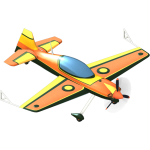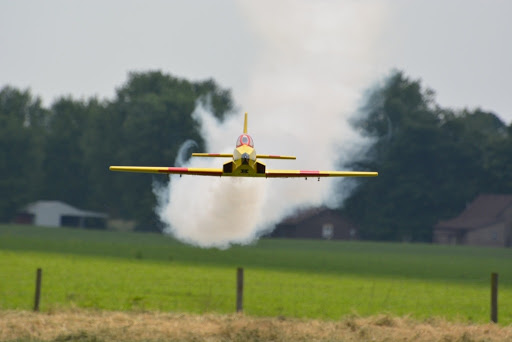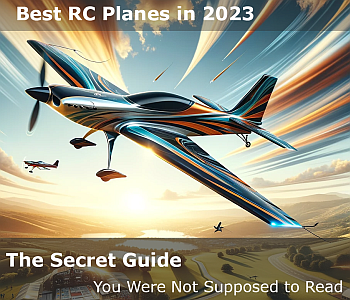Many of you will have seen the turbine-powered model aircraft perform at some of the RC model shows. At these shows, the Jet pilots are regularly asked the same questions by the interested public and pilots – How fast does it go? How much does it cost? Where can I buy one of these Jets? Where can I find out more information on turbine flying? So this is a little bit of how, what, where, and when on model jet aircraft in Scotland and how to get started.
“How much do they cost?” should be “I’d like to buy a turbine but how much will my wife allow me to spend on one?” If the answer is £200 max, then you won’t be flying turbines this year. The cheapest turbine to buy is around $1,300, which includes the Engine Control Unit and pump. Turbine Starting gear may also cost another $130 or so. You might be able to pick up a second-hand turbine for around $1,000, but be careful, the turbine should be checked over by someone that knows about these turbines.
Poorly maintained and operated turbines are not what you want to start with. I would recommend getting one of the Homebuilt turbines from either Simjet or Behotec. Both companies supply all the components and instructions to put the turbine together, plus get it running for around $1300 to £1700. Both these builds don’t require anything other than a few spanners, pliers, and a couple of hours of your time.
There are also fully built turbines on the market but they are very expensive and teach you nothing about how the turbines work internally. Fully built turbines start at around $2,700 and can go up to $5000 for the top of the range. You don’t get any more thrust or better reliability; you simply pay for someone else building it for you and the importer taking his generous cut. Remember these engines have fewer moving parts than a prop engine, they don’t wear out and need very little maintenance. Possibly only a bearing change every 50 – 100 hrs of flying at $70 a set
When it comes to starting the turbine for the first time, this is where you must talk to someone that’s got experience in operating this type of turbine. Don’t try it yourself or on your own, you may destroy the turbine if you’re lucky, you may seriously hurt yourself or someone else if you’re unlucky. Starting turbines is all about technique and safety. Preparations and knowledge make it look simple, but you have to learn the basic ground rules from an experienced operator.
Next, you want to think about the model type you want to build. The F15 Eagle would be nice or how about a Tornado swing-wing. Each of these models presents a long list of problems and technical issues that you will have to overcome before the model gets flying. These scale kits also cost a lot of money. So start with the simplest design to get you flying as soon as possible, so it’s back to the trainer, but not any old trainer. This one will do 160 mph on a straight pass and go vertical until out of sight if you so desire. There are several types of turbine trainers on the market and most of them are the flying wing design like the Kangaroo and the Hotspot. Not everybody likes these, so now there are a few more conventional layout models available that are good for grass and smaller fields. All the designs have one thing in common – the turbine is external to the model. Why? Because there’s a lot to learn to do with the turbine, its fuel system and how they fly. So if it’s on the outside of the model, you can see what you are doing. One other major advantage is you don’t have to worry about the airframe melting with the 590 oC exhaust.
When choosing the model there are a few things you have to think about, firstly, where can I put 1/2 a gallon of fuel? Is the model suitable for my turbine? Can the model fit in my car? Do I have a flying site that I can fly it from? If you have access to a good concrete runway like Balado, then your model choice will be unlimited. But if it’s at a short grass field, I’d recommend getting a high winged, conventionally laid out turbine trainer. In other words, it has strong fixed undercarriage, a large fuselage that can carry 1/2 gallon of fuel around the C of G, a normal rudder, an elevator, and a high wing with ailerons. A little ugly but you’ll learn so much by flying this model around regularly.
How much do the trainers cost? Around $350 to $700 depending on the style and complexity of the model. They normally take about a month of evenings to get them ready for their first flight. While your trainer is flying around, you can think about what you want next – possibly a Swing Wing F14 Tomcat or the F104 Starfighter or even a Red Arrows Hawk. The choice is yours, but you’re going to have to do some serious groveling to your wife first.
There are kit manufacturers somewhere in the world that’ll make the model jet of your choice. Even airliners are now appearing! The cost of some of these models ranges from $700 to a few thousand dollars. The top of the range Mig 29 will cost $6,200, then two turbines cost another $5700, then add the radio gear, another $1900. And before you ask, no you can’t get fully comp’ insurance on them.
The great thing about scale turbine models is the sound. They are the only scale models I’ve heard that sound close to the real thing. Compared to the prop boys, turbine-powered models would get top marks if ‘Realism in flight’ took into account their engine sound.



